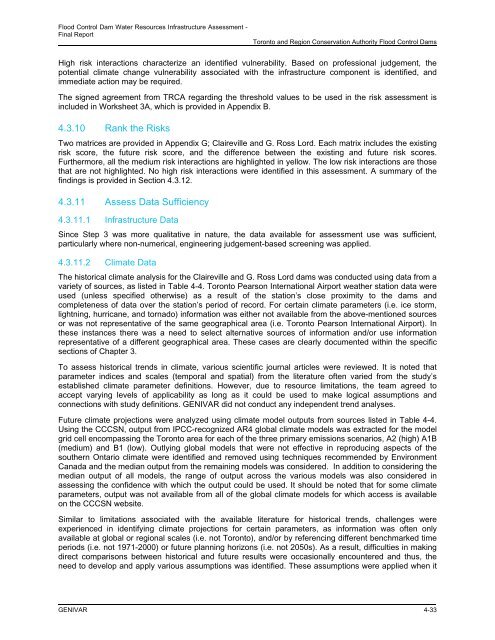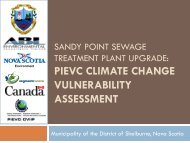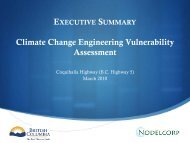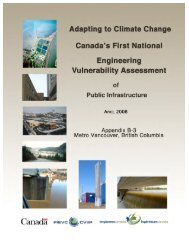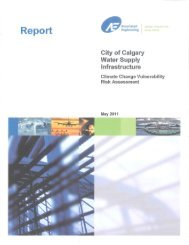Final Report - Vulnerability Committee
Final Report - Vulnerability Committee
Final Report - Vulnerability Committee
Create successful ePaper yourself
Turn your PDF publications into a flip-book with our unique Google optimized e-Paper software.
Flood Control Dam Water Resources Infrastructure Assessment -<strong>Final</strong> <strong>Report</strong>Toronto and Region Conservation Authority Flood Control DamsHigh risk interactions characterize an identified vulnerability. Based on professional judgement, thepotential climate change vulnerability associated with the infrastructure component is identified, andimmediate action may be required.The signed agreement from TRCA regarding the threshold values to be used in the risk assessment isincluded in Worksheet 3A, which is provided in Appendix B.4.3.10 Rank the RisksTwo matrices are provided in Appendix G; Claireville and G. Ross Lord. Each matrix includes the existingrisk score, the future risk score, and the difference between the existing and future risk scores.Furthermore, all the medium risk interactions are highlighted in yellow. The low risk interactions are thosethat are not highlighted. No high risk interactions were identified in this assessment. A summary of thefindings is provided in Section 4.3.12.4.3.11 Assess Data Sufficiency4.3.11.1 Infrastructure DataSince Step 3 was more qualitative in nature, the data available for assessment use was sufficient,particularly where non-numerical, engineering judgement-based screening was applied.4.3.11.2 Climate DataThe historical climate analysis for the Claireville and G. Ross Lord dams was conducted using data from avariety of sources, as listed in Table 4-4. Toronto Pearson International Airport weather station data wereused (unless specified otherwise) as a result of the station’s close proximity to the dams andcompleteness of data over the station’s period of record. For certain climate parameters (i.e. ice storm,lightning, hurricane, and tornado) information was either not available from the above-mentioned sourcesor was not representative of the same geographical area (i.e. Toronto Pearson International Airport). Inthese instances there was a need to select alternative sources of information and/or use informationrepresentative of a different geographical area. These cases are clearly documented within the specificsections of Chapter 3.To assess historical trends in climate, various scientific journal articles were reviewed. It is noted thatparameter indices and scales (temporal and spatial) from the literature often varied from the study’sestablished climate parameter definitions. However, due to resource limitations, the team agreed toaccept varying levels of applicability as long as it could be used to make logical assumptions andconnections with study definitions. GENIVAR did not conduct any independent trend analyses.Future climate projections were analyzed using climate model outputs from sources listed in Table 4-4.Using the CCCSN, output from IPCC-recognized AR4 global climate models was extracted for the modelgrid cell encompassing the Toronto area for each of the three primary emissions scenarios, A2 (high) A1B(medium) and B1 (low). Outlying global models that were not effective in reproducing aspects of thesouthern Ontario climate were identified and removed using techniques recommended by EnvironmentCanada and the median output from the remaining models was considered. In addition to considering themedian output of all models, the range of output across the various models was also considered inassessing the confidence with which the output could be used. It should be noted that for some climateparameters, output was not available from all of the global climate models for which access is availableon the CCCSN website.Similar to limitations associated with the available literature for historical trends, challenges wereexperienced in identifying climate projections for certain parameters, as information was often onlyavailable at global or regional scales (i.e. not Toronto), and/or by referencing different benchmarked timeperiods (i.e. not 1971-2000) or future planning horizons (i.e. not 2050s). As a result, difficulties in makingdirect comparisons between historical and future results were occasionally encountered and thus, theneed to develop and apply various assumptions was identified. These assumptions were applied when itGENIVAR 4-33


